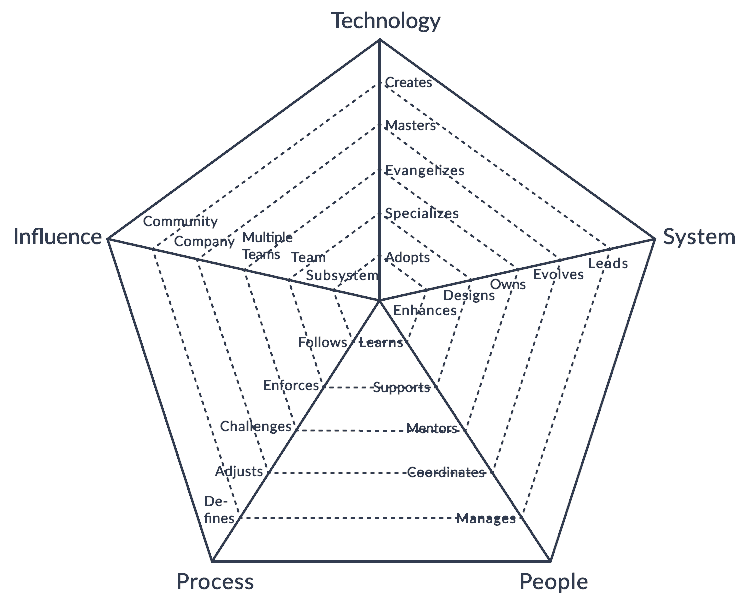Defining and implementing career ladders
Tips, guidelines, and some steps… ;-)
In software engineering management, a career ladder stands as a strategic blueprint, encapsulating the progression of roles within a company. It charts the course of promotions, salary increments, and evolving job responsibilities, ultimately guiding individuals toward esteemed senior positions.
It’s important to consider the roles as they are now and what they need to be so the company can succeed. For this reason, defining career ladders should consider the titles that exist in the company with current requirements and what exists in the market.
A good ladder distinctly defines entry-level to high-level positions, describing which technical and interpersonal skills an individual must demonstrate to be considered ready to take on a different position.
Importance of a Career Ladder
A career ladder provides a tool an individual can rely on to improve their value in alignment with the organization’s needs. It’s also an important management tool to identify gaps in the organization, provide organizational training, and support career coaching done by managers with their direct reports.
On the other hand, very high-level roles are often defined individually, depending on the skills required for a certain business area, strategic objectives, and company culture. It’s common to see career ladders excluding very high-level roles, such as the C-level.
Defining Career Ladders

I can’t emphasize enough the importance of doing this with the support of HR personnel. If you touch on salary ranges, bonuses, etc., you must engage with people responsible or delegate this part completely if the information is above your pay grade. These are all sensitive discussions that will have a lot of impact on the organization.
Here are the main steps:
Conduct a Skills and Competency Assessment
- Identify key skills required for success.
- Assess current and future organizational needs.
Develop a Competency Framework
- Create a framework outlining skills and behaviors for each ladder level.
- Include technical and interpersonal skills.
- Consider roles that are not present in the organization.
- Compare the existing roles with the expectation for these roles outside the organization.
Align with Organizational Goals
- Ensure alignment with overall strategic goals.
- Connect skills and competencies to business and engineering needs.
Establish Clear Job Descriptions
- Clearly define roles and responsibilities at each level.
- Articulate expectations for performance.
- Link achievements to recognition and rewards.
Define Promotion Criteria
- Clearly articulate promotion criteria.
- Specify skills, experiences, and accomplishments required.
- It’s important to highlight which items are required or nice to have.
Involve Stakeholders
- Gather input from employees, managers, and leadership.
- Consider diverse perspectives.
Encourage Employee Input
- Seek feedback on the ladder structure.
- Incorporate employee aspirations into refinements.

Implementing Career Ladders
Once the ladder has been defined, it’s time to put it into practice. Just making it public on the organizational wiki is not enough. That’s especially true if titles change because signatures may be required. Even if it’s not the case, training on how to use this tool effectively will be required.
The main steps are:
Train Managers on Career Development
- Provide training on supporting employee growth.
- Equip managers for career discussions and development plans.
Establish Performance Review Processes
- Implement regular performance reviews.
- Use assessments for improvement and recognition.
- Celebrate employee accomplishments.
Map Learning and Development Opportunities
- Identify opportunities supporting skill acquisition.
- Develop training, mentorship, and coaching resources.
Communicate Clearly
- Clearly communicate ladder structure and expectations.
- Provide resources for career progression understanding.
Create Succession Plans
- Use the ladder for succession planning.
- Identify and develop high-potential employees.
Iterate and Improve
- Regularly review ladder effectiveness.
- Make adjustments based on feedback and changes.
By following these steps and best practices, organizations can develop an effective and transparent career ladder, supporting employee and organizational success. Regular reviews ensure the ladder remains relevant to evolving needs.
Defining roles
Defining roles may be the most complex step. I often see organizations starting from this step, trying to define the roles based on observation and subjective expectations. However, this often leads to biases leading to organizational needs not being represented when gaps are present during the analysis.
My first advice is to start from recent job descriptions for the existing roles and rely on external references to consider important requirements that may be missing. This activity also helps align the titles for each position with industry practice.
To my knowledge, the best external sources to support this activity in Software Engineering are:
- progression.fyi: a collection of public and open-source career frameworks from the world’s best companies.
- engineeringladders.com: a framework for Engineering Managers.
Conclusion
A well-crafted career ladder in software engineering is a strategic roadmap aligning individual growth with organizational goals. Career ladders also act as management tools, aiding in gap identification and targeted training.
Defining career ladders involves many steps, from skills assessments and competency frameworks to alignment with organizational goals. Implementation requires investment in manager training, robust performance reviews, and proactive communication, fostering a culture of growth and success.
Cheers!